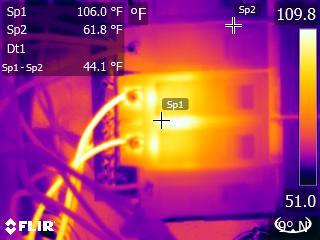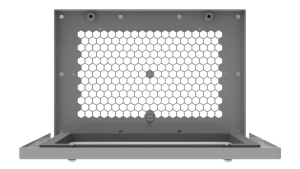Thermographic Analysis
 By performing an infrared inspection, valuable information can be acquired in order to develop a predictive maintenance program for your facility. Until a failure brings them to your attention, problems, which normally remain hidden, can be found early and the causes identified.
By performing an infrared inspection, valuable information can be acquired in order to develop a predictive maintenance program for your facility. Until a failure brings them to your attention, problems, which normally remain hidden, can be found early and the causes identified.
Corrective actions taken will save you money, inconveniences and may just save a life. Conditioned monitoring of equipment can be accomplished by doing a thermal infrared imaging analysis periodically.
Comparative thermography can be used to provide the best available data in lieu of ideal thermal measurement capabilities. Changing load considerations, techniques in performing rough emissivity estimates, and the ability to differentiate emissivity differences on energized or rotating equipment give the thermal infrared technician the ability to provide useful information under the less-than-ideal circumstances frequently encountered in the field.
Inspection Windows
See what you can’t see!
 Infrared viewing windows allow for thermography to be performed on gear when the hazard of removing covers is too great and on certain low voltage enclosures or medium voltage enclosure designs and door interlocks that do not allow for the safe removal of the equipment covers or the opening of doors, which is required for the inspection of the internal components and connections of the equipment.
Infrared viewing windows allow for thermography to be performed on gear when the hazard of removing covers is too great and on certain low voltage enclosures or medium voltage enclosure designs and door interlocks that do not allow for the safe removal of the equipment covers or the opening of doors, which is required for the inspection of the internal components and connections of the equipment.
We recommend the installation of infrared inspection windows to allow for the safe and complete inspection of this equipment when we are performing your annual infrared inspection services.
Ultrasonic Inspections
Hear what you can’t see!
An ultrasonic inspection can detect corona, arcing and tracking in the
higher voltage electrical equipment, as well as vibrations in transformers. This type of inspection is used to locate possible issues inside electrical equipment, which allows for a safe inspection without needing to open the equipment.
NOTE: The 2023 edition of the NFPA 70B represents a significant shift in the approach to electrical equipment maintenance. Previously considered a “Recommended Practice”, NFPA 70B is now a “Standard” containing mandatory language and requirements.
This now requires the development, implementation and operation of an electrical maintenance program (EMP). It provides a framework to safeguard people, equipment and processes from electrical system failures.
Performing annual infrared inspections are essential for meeting the minimum requirements of an electrical maintenance program.
For more information, or to get a quote, please contact Mike Sumner.
PH: 781-760-0676 or E: mike.sumner@infraredbps.com

